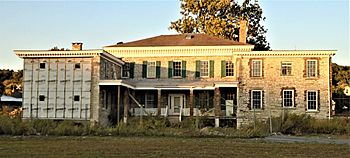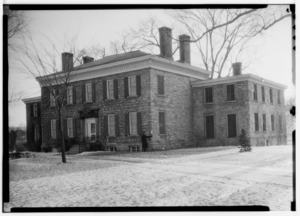Guy Park facts for kids
Quick facts for kids |
|
|
Guy Park Manor
|
|

View from the Mohawk River side (2020)
|
|
| Location | W. Main St., Amsterdam, New York |
|---|---|
| Built | 1774 |
| Architectural style | Georgian |
| NRHP reference No. | 73001206 |
| Added to NRHP | February 6, 1973 |
Guy Park is a historic house built in 1774. It's also known as Guy Park State Historic Site or Guy Park Manor. The house was built for Guy Johnson, who was an important British official. He was in charge of relations with Native American tribes in colonial New York. The house is made of limestone and sits near the Mohawk River. This location was great for travel by water.
Contents
Meet Guy Johnson
Guy Johnson was born in Ireland. He moved to New York when he was young. He settled in the Mohawk Valley, where his uncle, Sir William Johnson, lived. Guy married his cousin, Mary Johnson, also called Polly. In 1773, Sir William gave Guy and Polly a large piece of land as a wedding gift. They built a house there, but it burned down in a lightning strike the next year.
Building Guy Park
After the fire, Guy Johnson decided to build a new house. He chose a style called Georgian, which was popular at the time. This new house, built in 1774, is the one we know as Guy Park.
Later in 1774, Guy Johnson's uncle died. Guy was then chosen by the British King to take over his uncle's important job. He became the British Superintendent for Indian Affairs. His main goal was to keep the powerful Iroquois nations allied with the British. This was important because tensions were growing with the American colonists.
Leaving Guy Park
As the American Revolutionary War began, Guy Johnson was a Loyalist. This meant he supported the British King. Many local settlers wanted independence, so Guy was in danger. In 1775, he gathered his friends and left the area. He had to leave his mansion behind. Sadly, his wife Polly died during their journey to Canada.
From 1776 to 1778, Johnson lived in New York City, which the British controlled. By 1779, he moved his base to Niagara, Ontario, in Canada. From there, he led British forces against the American rebels. After the war ended, he moved to London, England. He died there in 1788.
About the House
The Guy Park house was built in 1774. It is made of strong limestone. The house has two stories and is built in the classic Georgian style.
History of Guy Park
After the American Revolutionary War, the new governments of the United States and New York made a decision. They said that Loyalists who went to Canada were traitors. The state then took their properties, including Guy Park. The state later sold Guy Park to a private owner.
Many people began moving west along the Mohawk River. They were settling lands that once belonged to the Iroquois. Guy Park was located on a main road, the Mohawk Turnpike. It was also right next to the river, which were the two main ways to travel across the state.
A Busy Stop
For many years in the early 1800s, Guy Park was a popular place. It was used as a tavern and a stop for stagecoaches. In 1825, the Erie Canal was finished. A canal lock, which helps boats move between different water levels, is located near the house. Later, the house was sold again and became a private home for many years.
Becoming a Museum
In 1907, the state of New York bought Guy Park. They wanted to save it as a historic site. In the early 2000s, the house became a local history museum. It was called the Walter Elwood Museum. Walter Elwood was a history teacher who started collecting items in the 1930s.
The museum showed many interesting things from his collection. These included historic objects made by the Mohawk and other Iroquois tribes. There were also items about the Erie Canal, the local carpet industry, and the city of Amsterdam.
Damage and Future
In August 2011, Guy Park was badly damaged. The Mohawk River flooded after Hurricane Irene. Half of two floors were destroyed, and everything inside got wet and scattered. The state has been working to fix the building. The Walter Elwood Museum has since moved to a new location.
Today, Guy Park is listed on the National Register of Historic Places. This means it is recognized as an important historical building.
Images for kids







